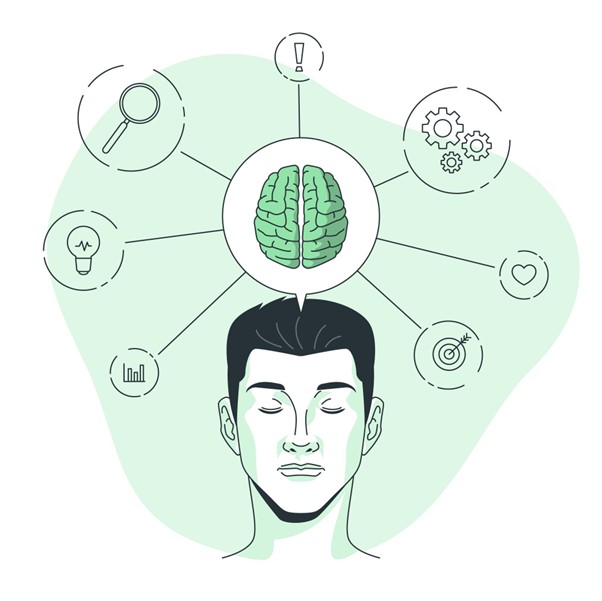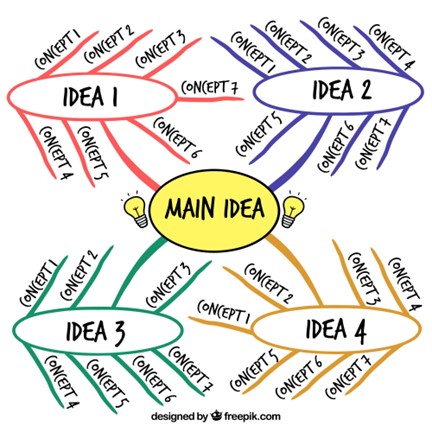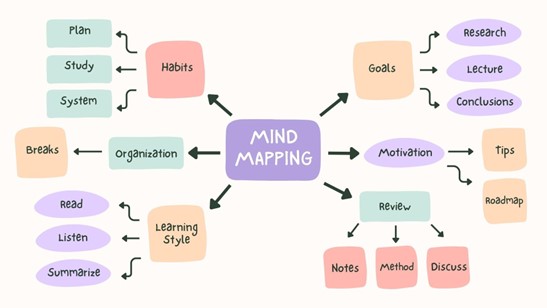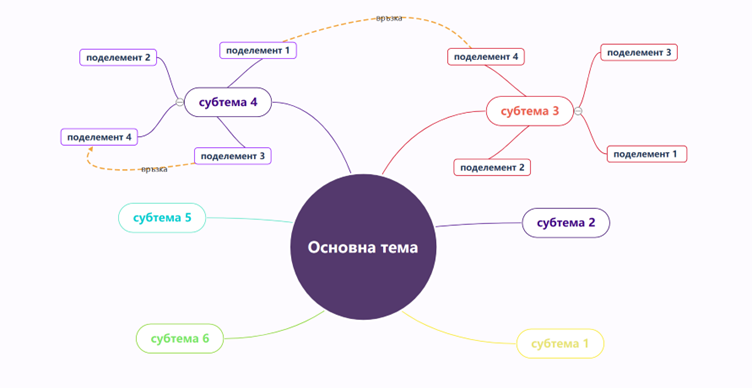What is a mind map and how is it created?

Георги Радивойевич | 1 February 2024
Imagine that a fantastic idea strikes you, and you can't wait to bring it to life. Numerous details start emerging around it, and in the chaos of thoughts, you can't figure out where and how to start and whether the idea is truly brilliant. What is important and what is secondary, what must be present, and which elements are unnecessary...
Mind maps are created for moments like this. When a brainstorm creates an abstract puzzle in our minds, a mind map can crystallize the idea, give it a clear shape, and outline the key aspects that need attention.
It has been proven that the brain processes information more effectively when presented with a visual stimulus. Knowledge maps, also known as mind maps, rely precisely on this principle.
What is a mind map and what does it look like?
It represents a scheme or diagram, usually center-oriented, in which a specific idea, thought, task, goal, or general information is depicted through key words and branches.
Various colors and shapes can be used to contribute to the presentation of information, and mind maps can be created manually or with the help of computer software.
They typically have a similar appearance but can take various forms.


The main idea is placed in the center, followed by the creation of primary branches or main categories. Each subsequent branch delves into deeper details.
Advantages of working with mind maps.
Designing a mind map facilitates the organization of information, encourages associative thinking, and supports taking specific steps. Mind maps are the practical embodiment of the principle that the human brain operates most effectively when working with information presented in an organized, connected, and visual model.
Moreover, they mimic the natural way the brain processes information.
From a scientific standpoint, creating a mind map engages both halves of the brain - creative and analytical, unlocking it at a deeper level and utilizing its capacity more comprehensively.
A modern practical model derived from an old psychological technique.
Many sources indicate that the first mind map was created by psychologist Tony Buzan in the second half of the 20th century, but there is evidence of even earlier instances of similar information representation dating back to the 3rd century.
During that time, the philosopher Porphyry of Tyre created a diagram, now known as Porphyrian Tree or Porphyry's tree, in the introduction to one of Aristotle's works. This diagram helped Porphyry illustrate his own ideas regarding the work of his predecessor.
What are mind maps used for?
Visual knowledge maps are a great aid for presenting, organizing, navigating, understanding, and memorizing information. That's why they find wide application in various life situations, in education, and in the business sphere.
They are used as a means of organizing information, facilitating learning, clarifying ideas, and brainstorming. They serve students, teachers, professors, professionals, and ordinary people. In practice, they are applicable in every field where visualization of knowledge is sought.
They help with effective planning, making lists, preparing presentations, taking notes, problem-solving, structuring processes, project management, personal growth, and the list goes on.
Uses of mind maps in digital marketing
Creating a mind map is also a practical technique for planning and implementing ideas in the field of digital marketing. We use them to develop marketing strategies, for brainstorming, and planning campaigns in a format that is easy to work with and digest. Here are a few specific aspects in which you can use this knowledge model.
- Building a brand identity
Illustrate the core of the brand and create branches that represent its values, mission, and vision. Include the words that best describe it and which you will focus on in your campaigns.
- Planing impactful content
Utilize the power of brainstorming and generate ideas for fresh content to keep the audience engaged. Gather the best ones and create a content calendar.
- Visualizing the target audience
Better understand the brand's target by delineating its various segments, defining individual profiles, and identifying their main preferences and behaviors.
- Configuring a web of channels
The mind map can help you outline the main channels you will use for a prominent digital presence of your business. Note the strengths and weaknesses of each platform and connect the channels with the preferences of the audience and your marketing goals.
Steps in creating a mind map

The mind map model is extremely easy to understand and construct. It can be used to create both simple visualizations and complex concepts, depending on the idea or problem you are focusing on. Here are the main steps that can guide you through the process.
Step 1: Defining the center
The central idea, thought, key word, problem, or concept is placed in the center. You can always choose a different structure, such as a hierarchical one that goes from top to bottom, but the classic model starts from the center.
The idea is to leave more space for placing individual branches from one level, as well as to visually focus on the main element around which everything else revolves. This way, you direct where thoughts should be focused.
Here you can place, for example, a specific marketing campaign or SEO content strategy for the website, which outlines the subject of the map.
When applicable, use an image instead of words for the center, as it provides a stronger visual stimulation of thoughts.
Step 2: Create the main branches
These are the first "branches" that you need to directly connect with the central element. Here, you place the basic themes or sub-themes. The branches will help you start organizing the information. Aim to place them at equal distances from the center.
If you have placed a particular problem in the center, the primary branches could be the main pathways through which it can be resolved.
In the example of a digital marketing campaign as the central element, the main branches could be "target audience," "marketing channels," "content strategy," and so on.
Step 3: Add secondary branches
Create sub-branches for each main branch. Secondary branches reveal specific aspects of the central theme directly related to a particular sub-theme.
For instance, the secondary branches of the main element "target audience" could include demographics, interests, and online presence.
Then, you can add additional branches to each sub-branch, and so on, until you exhaust all the questions you want to address in the mind map.
Step 4: Connecting separate elements
If there are certain semantic connections between individual elements, regardless of their level in the system you've constructed, you can denote them on the map. Connect the elements with lines and explain the relationship between them with key words on the line.
Step 5: Final edits
For additional visual stimulation, use different colors and shapes. Where applicable, you can add shapes and images that create quick associations.
You can color the branches according to the sub-theme they fall into for quicker orientation.
Create emphasis on key points.
Mind mapping software
Manual creation of mind maps is preferred in the realms of personal growth and for personal projects by individuals who receive positive stimulation from creating visual elements by hand.
In the professional sphere, specialized software is more commonly used, greatly facilitating the creation of even the most complex mind maps. The good news is that there are many freely accessible online tools that provide the opportunity to create excellent mind maps.
Excellent free online tools for creating mind maps include Ayoa, Invision, Gitmind, Figma, Mindomo, MindMup, and others. Canva also offers free templates for designing mind maps.
It is important for the tool you use to allow access to the map by different users and to have an option for them to edit it. Integration with other tools and mobile adaptability are also key factors.
For use in a professional environment, we recommend paid software, as this guarantees the security of the information you enter when creating the mind map, as well as of the final product. Most of the aforementioned tools have full paid versions offering more functionalities and connectivity options.
An excellent option can also be found among Google's tools. MindManager is also a good professional choice.
Frequently asked Questions
What are the benefits of creating a mind map?
Множество изследвания показват, че мисловните карти успешно стимулират креативността, асоциативното мислене и запаметяването и са отлично средство за решаване на проблеми. Освен това са ефективно пособие за планиране, организиране и систематизиране и помагат за бързото и лесно предаване и възприемане на информация.
How to make a mind map?
A mind map is created in the form of a diagram or schema, organized centrally around a specific idea, problem, goal, task, or concept. The three main elements that should be present are the center, associations, and branches. Start from the center and create primary and secondary branches related to the central subject.
Use key words in creating the individual elements, lines to connect them, shapes, forms, and colors for facilitation and additional visual stimulation.
What are the best free tools for creating mind maps?
The best free tools for creating mind maps should provide extensive options for development and customization. In this regard, we recommend trying tools like Gitmind, Figma, Mindomo, MindMup, Ayoa, and Canva.